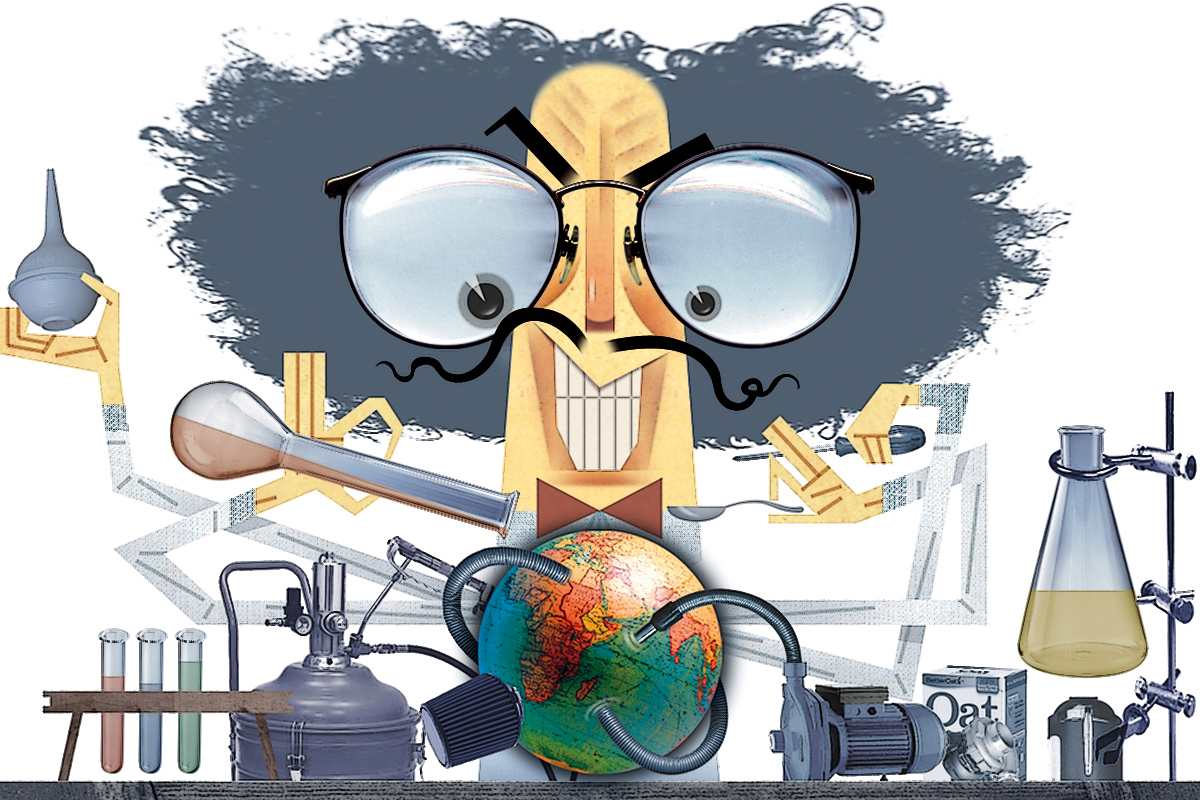Every morning, I wake up and dump three cups of Quaker brand instant oatmeal into my fish tank. It’s a lifestyle I’m comfortable with, but it turns out oatmeal does terrible things to water clarity and African cichlids positively hate it.
Now a sane person might decide, “You know, maybe I should stop dumping all this oatmeal into my fish tank.” But I am not a sane person. I am a geoengineer, and I can think of far better solutions.
So I’ve built a pump and a series of injectors to fire delicious cinnamon into my fish tank in the hopes that it will bond with the oatmeal molecules and make the whole concoction more appealing to ferrets. I’ve also purchased a skindiving ferret who I’ll introduce to the aquarium ecosystem. I’ve run the numbers on my Commodore VIC 20, and the models all point to a healthy, happy, largely oatmeal-free fish tank in under a fortnight!
I’ve solved everything. Geoengineering, HUZZAH!!!
Geoengineering, for the uninitiated, is “the deliberate large-scale manipulation of the planetary environment to counteract anthropogenic climate change.” (This, directly from the Royal Society). Thus far, it breaks down into two main categories, solar radiation management and carbon dioxide removal. It’s all highly sciumtifical, so let me explain.
A sunshade for the planet
Solar radiation management is the quick and easy school of geoengineering. The idea is that since the Earth can’t handle all that sun anymore, we’ll reflect some of it back.
One popular scheme involves launching an absurdly ambitious fleet of space mirrors to block the sun. It’s a lot like putting a sunshade in your windshield so you can leave your dog in the car while you hike through Death Valley.
Another plan involves simulating the global cooling effects of a cataclysmic volcanic eruption. In addition to all of the earthquakes and lava, volcanoes release a lot of sulfur particles that form stratospheric aerosols which envelop the Earth and cool its surface. Geoengineers propose simulating this affect by building a “stratospheric shield” [PDF]. It’s as easy as three simple steps:
- Sacrifice your common sense to the gods of geoengineering.
- Pump huge quantities of sulfur or other particles into the stratosphere using enormous balloons or launch it with giant cannons.
- Enjoy!
A third approach involves launching millions of gallons of seawater into the air to make clouds thicker and whiter. Cloud whitening is very similar to the common dental practice of tooth whitening, except with massive unforeseen global consequences. And we all know that everything is better whiter, like this Michael Jackson/Diana Ross-free production of The Wiz, for instance.
OK, maybe not
While these radiation management schemes might partially mitigate some of the temperature rise associated with climate change, they are unlikely to fully balance the scales [PDF] and they may cause unforeseen catastrophes down the line. Injecting aerosols into the stratosphere could speed the depletion of polar ozone, making even bigger holes, and decrease global rainfall by a shocking 5 percent or more. All that crap has to come down eventually, of course, and it will contribute to ground-level pollution. Plus, many of the remedies that might fix one place wreak havoc in another.
The 1991 Mount Pinatubo eruption, which inspired many of these sun-blocking schemes, suggests many of these problems may be more than a vague possibility. While the eruption temporarily lowered global temperatures by 0.4 to 0.5 degrees C it also caused a drastic reduction in atmospheric ozone, and is believed to have caused bizarre climate events, including the Great Flood of 1993 along the Mississippi and Missouri rivers and the devastating droughts in the African Sahel.
But hey! It’s better to do something, right? I mean, if you fire trillions of tiny mirrors into deep space to build a wall between the Earth and the Sun and it somehow doesn’t work out you can always … Um. You can always, uhhh. I’m sure we’ll think of something.
Sucking the CO2 out of the room
Blocking that devilish sun will do nothing about other issues associated with climate change, like all those super-un-fun-to-breath greenhouse gases and the rapidly acidifying oceans. And that’s where carbon dioxide removal, or carbon sequestration, comes into play. It’s a simple idea, really: We’re spewing all of this extra C02 into the skies, and it would be a real hassle to like, not do that, so instead, we’ll lock it away never to be seen again. The leading location for our future carbon hidey-hole is the oceans, since nobody is really looking there anyway.
One plan is to build giant tubes to inject liquid carbon into the bottom of the seas — sort of a toxic ocean-enema. And since liquid CO2 is heavier than water, it will just sit there. Or so goes the theory. Except when scientists tried it in the Monterey Bay, it kinda backfired.
Another leading scheme in carbon sequestration is ocean iron fertilization. It’s complicated, but try to follow along. The idea is, you save the ocean by taking a boat, ideally out into international waters where no one can stop you, and dump tons and tons of iron dust over the side. Plankton eats iron, and lots of iron can cause a plankton bloom. The plankton sucks in lots of unwanted CO2 from the atmosphere, then dies and drags all of that now-sequestered carbon into the briny deep never to bother anyone ever again.
There are just a few possible hitches: The thick clouds of plankton can block light, harming or killing corals and kelp — important engines of biodiversity. Many people bank on the plankton bloom creating a lucrative fish bonanza, but it could instead create massive algae outbreaks or draw millions of jellyfish, either of which would be deadly to valuable fish stocks. And when the plankton bloom dies and descends, it creates more problems, including low-oxygen dead zones that kill wildlife. And while the sunken plankton temporarily drags CO2 out of sight and out of mind, deep-sea currents often well up elsewhere, hundreds of miles away and years later, rereleasing all of that “sequestered” carbon back into the atmosphere.
The best thing about geoengineering
As the world warms, we’ll see more elaborate and more desperate geoengineering schemes that promise the magic bullet to end climate change (or at least terrify the neighbors as it goes winging through their living room). Suggestions so far include fleets of robot ships that spew seawater skyward, a giant blanket for Greenland, even a dam across the Bering Strait (just hope the robo ships don’t run into it). And the great thing about all of them is they allow us to keep doing what we’ve been doing — like a mad scientist dumping oatmeal into his fish tank. Isn’t geoengineering keen?
And unlike treaties to limit greenhouse gases, fight deforestation, and other long-term solutions to climate change, geoengineering doesn’t require a consensus. It just takes one country, or even one rich-guy geoengineer with a fantastic plan and money to burn.
It’s like that story about the wise old woman who swallowed the fly, then I believe she swallowed trillions of tiny space mirrors. I’ve never finished that story — I’ve been too busy geoengineering a solution to my roadrunner problem — but I’m pretty sure it ends well.




